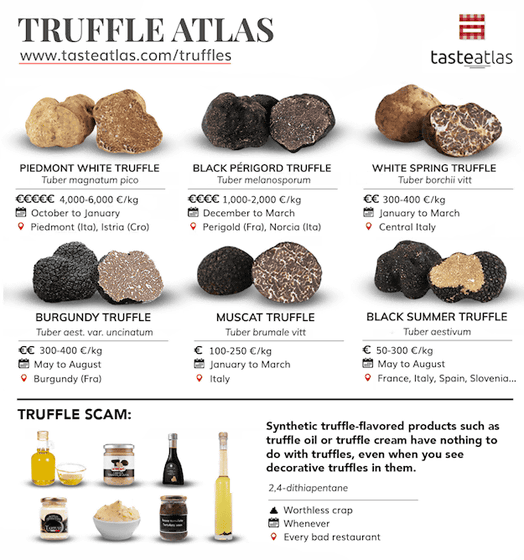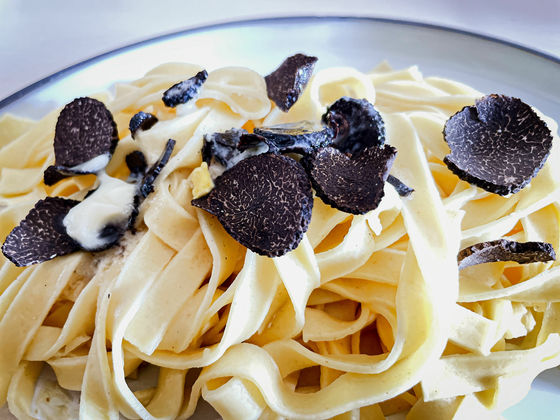It is pointed out that truffle salt, truffle oil, etc. are not using real truffles, but are tasteless, odorless, and inferior in appearance, even if they are eaten thinking that they are ``real truffles.''

There are many processed foods with
The truffle industry is a big scam. Not just truffle oil, everything
https://www.tasteatlas.com/truffle-industry-is-a-big-scam
In Barcelona, Spain, there is a popular bar ' Quimet & Quimet ' among tourists. Machneyuda , a popular restaurant in Jerusalem, is popular for using truffle oil in its polenta . As you can see, there are many restaurants that make a big appeal of foods named 'truffle' such as truffle oil and truffle salt. A restaurant in Croatia's Istrian peninsula displays real truffles shaved and soaked in oil as a display, but it seems that ordinary truffle oil is actually used in cooking.
TasteAtlas says, ``Many may already know that truffle oil is not made from truffles. As you can see, there is a lot of garbage in the world that uses the name 'Truffle', a well-known luxury food, to clearly mislead customers and misrepresent products that have nothing to do with truffles. It's a thing, 'he points out that foods with the name 'truffle', such as truffle oil, do not use real truffles.
There are various foods that use truffles, such as potato chips, ketchup, chocolate, tartufata (black truffle sauce), cheese, and sausages. is pointing out.

There's no shame in not knowing that truffle oil and such don't use real truffles. Quality truffles are so hard to find that most chefs and journalists are unaware that they aren't using real truffles, says TasteAtlas. Even experts misunderstand that truffle oil is made with real truffles just because of the 'truffle pieces' that are put in the truffle oil as a decoration. However, ``Most of the foods that are actually used in restaurants or sold at retail stores with the name ``truffle'' are fraudulent products that are only flavored with synthetic truffle flavoring.'' TasteAtlas points out again.
What is the synthetic truffle flavoring used in many foods named
Therefore, TasteAtlas says, ``Even if you don't like the smell of truffle dishes in restaurants, it may not mean that you don't like truffles. The scent is mild and very complex.”
'But the food I had at the restaurant had real truffles on it,' you might say. This is 'the worst part of truffle fraud in the food industry,' TasteAtlas points out. Not all truffles are like that, but some that are marketed as real truffles are simply decorations that have no taste or smell, says TasteAtlas. Such tasteless and odorless truffles are offered together with truffle oil scented with synthetic truffle fragrance at the time of provision, and the selling price is said to be cheap. There are more than 60 types of truffles, of which about 25 are edible and about 4 are commonly used.
The most expensive and precious truffles are the white truffles that can be harvested in winter, specifically from around September to the end of January. The world's most famous white truffles are collected in Alba, Italy and Istria, Croatia, and depending on the season, they may be traded at nearly 10,000 euros (about 1.4 million yen) per kg.
Black truffles harvested in winter are also precious and expensive. Black truffles can be picked from early November to mid-March, and the most famous black truffles come from Perigord, France. These black truffles are traded for tens of thousands to hundreds of thousands of yen per kilogram.
These winter truffles (winter truffles) cannot be harvested in any season other than winter. It is also impossible to offer these truffles out of season as they cannot be frozen, cooked, sterilized or packaged. So if you're serving these truffles out of season, 'it's definitely a truffle scam,' points out TasteAtlas.

On the other hand, black truffles such as 'Tuber aestivum' can be collected in large quantities almost all year round at the base of trees such as oak, hazel, poplar, beech, and pine trees. These truffles, called summer truffles, grow near the surface of the earth and are relatively easy to find, so prices are relatively cheap, starting at 100 euros (about 14,000 yen) per kg. The difference between winter truffles and summer truffles is that summer truffles have a black outer skin and a bright core, and the scent of summer truffles is very mild.
Even worse than this is the Chinese black truffle, which is flooding the European and American markets, TasteAtlas points out. Black truffles from China are tasteless and odorless, and the price is very cheap at less than 10 euros (about 1400 yen) per kg. It looks the same as the expensive black truffles harvested in winter, but the flavor is completely different. Poor quality black truffles from China are sometimes called 'potatoes' because they are not much different from potatoes in terms of price and taste. If you see truffles with darker cores in the summer, 'definitely a scam,' notes TasteAtlas.

Furthermore, TasteAtlas explains how to serve truffle dishes correctly: ``Real truffles are mild and expensive. There is no point in hiding it, so the only correct way to serve a truffle dish is to have a mild, neutral dish (such as a simple pasta with butter) and grate the truffles in front of your guests.” is mentioned.
In Alba, Italy, after the food arrives in front of you and confirms that there is no synthetic truffle fragrance, the waiter weighs the truffle and grate it on a plate until the customer says stop. increase. After grating, the waiter weighs the truffles again and charges you according to the amount used. Truffles are provided in such a correct way, except for Italy and France, 'almost none'.

All products with the name 'truffle' on supermarket shelves are scented with synthetic truffle flavoring. There are cases where these products are written as 'use of natural aroma', but this refers to the fact that the oil extracted from plants and animals is used, and it is a real truffle-derived oil. It doesn't seem to indicate something. Even with truffle oil that contains real truffles in a bottle, as mentioned above, cheap truffles with no flavor are put inside, and synthetic truffle flavoring is used to flavor the oil.
The problem lies with restaurants that use truffle oil or cheap truffles and offer menus that are priced as if they are serving expensive natural truffles, TasteAtlas said. The only way to avoid this is to ask the restaurant staff if they are using real truffles, smell the food before putting it on, and have the waiter grate the truffles right in front of you, says TasteAtlas. said.
Related Posts:
in Food, Posted by logu_ii







